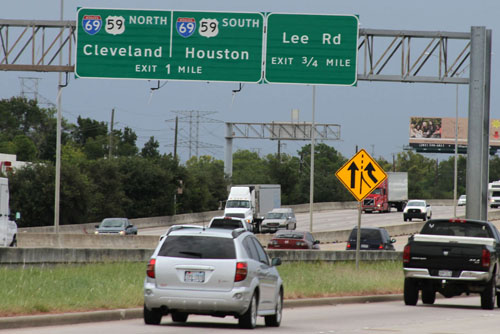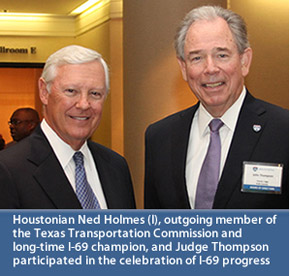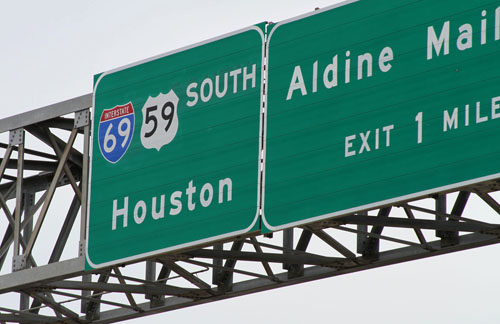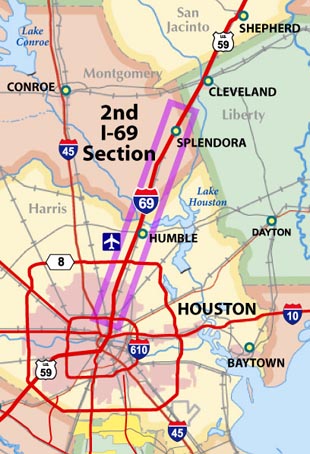• Alliance and Friends Celebrate as I-69 Signs Go Up in Houston Area
The first Interstate 69 signs are going up in the Houston area and champions of I-69 are celebrating. The Alliance for I-69 Texas, local leaders and TxDOT held a ceremonial sign unveiling on Sept. 13th and talked about the substantial progress that is being made on advancing I-69.
 Large gantry signs are going up along 35 miles of the Eastex Freeway starting at Loop 610 and running north past Humble and ending just beyond the Montgomery-Liberty County Line. Major sign work should be completed by early November and dozens of additional directional signs will be installed on ramps, feeder roads and cross streets over the next few months. The highway is now dually designated as I-69 and US 59.
Large gantry signs are going up along 35 miles of the Eastex Freeway starting at Loop 610 and running north past Humble and ending just beyond the Montgomery-Liberty County Line. Major sign work should be completed by early November and dozens of additional directional signs will be installed on ramps, feeder roads and cross streets over the next few months. The highway is now dually designated as I-69 and US 59.
In Texas, I-69 is being created through the conversion and upgrading of existing highways. At some point I-69 in Texas will be connected to proposed I-69 segments being considered in Louisiana, Arkansas, Mississippi, Tennessee, Kentucky and Indiana.
During the sign unveiling media briefing, Jeff Austin III, Texas Transportation Commission member, called the addition of the 35-mile section to the Interstate Highway System "a huge step forward."
He explained that because of a recently approved change in federal law it will be possible to add more than 200 miles of existing freeways to I-69. They are in the Houston area, at Texarkana and in Cameron and Hidalgo Counties in the Rio Grande Valley. TxDOT is working with federal officials to evaluate the sections and Austin anticipates most of the sections will be added in 2013. This provision is being used to take a close look at sections of US 59, US 77 and US 281 that were designated as part of the I-69 planning corridor by the US Congress.
He said they are also working with federal officials in an effort to add a 46-mile stretch of existing US 83 freeway in the Valley to the Interstate Highway System as an I-69 connector. It runs from Harlingen west to Mission and Palmview and provides access to several major international bridge crossings.
The commissioner also noted that TxDOT has approved more than $600 million for projects and studies of projects to make incremental progress on I-69. This includes a project in Liberty County that once completed will mean the interstate can march northward past Cleveland and Shepherd.

FORT BEND AND WHARTON COUNTIES
He reported that TxDOT's Houston and Yoakum Districts are working together to identify projects that will speed the process of extending the I-69 freeway through Fort Bend County south of Rosenberg and on through Wharton County.
Austin said this level of progress has only been possible because of the sustained effort of the I-69 Alliance and the work of citizen committees that have been helping determine how I-69 will be developed in Texas. Five citizen committees were established along the I-69 routes in 2008 and the members were asked to listen to the public and come back with recommendations.
 John Thompson, Alliance for I-69 board chairman and Polk County Judge, stressed that the citizen planning concept being employed on I-69 has been bringing decisions from the bottom up rather than the top down.
John Thompson, Alliance for I-69 board chairman and Polk County Judge, stressed that the citizen planning concept being employed on I-69 has been bringing decisions from the bottom up rather than the top down.
Domingo Montalvo, mayor of Wharton, is the chairman of the Segment 3 Committee which looked at the area from Houston to south of Victoria. He said that citizens and community leaders had been very responsive and that the committee followed their input closely. "People in the area south of Houston want the interstate highway designation because they know what kind of economic bonus that it is going to be for their area," he said.
Jim Wehmeier, executive director of the Lufkin Economic Development Corp., is the chairman of the Segment 2 Committee which looked at the area from Houston north to Lufkin. He said the he was honored to be one of the citizen planners engaged in the ongoing process of identifying and prioritizing I-69 upgrade strategies. "We let TxDOT know how we want it to look and function."
He said this shift in project development to utilizing citizen planners is a critical moment -- a shift that will be very important in moving needed Texas transportation projects forward in the years ahead.
Designation of the North Houston section as Interstate 69 was previously approved by the Houston-Galveston Area Council, the American Association of State Highway and Transportation Officials, the Federal Highway Administration (FHWA) and the Texas Transportation Commission.
TxDOT has been aggressively investing in rebuilding US 59 through Montgomery, Harris and Fort Bend counties during the past 20 years. With only minor exceptions these sections far exceed interstate highway standards and are ready to go as I-69. Much more investment will be needed in South Texas and East Texas where existing highways lack full access control and will require dozens of new grade separations at intersections. A limited number of locations will require relief routes around cities and towns.
TWO MORE HOUSTON AREA SECTIONS COMING
Commissioner Austin reported that in the next few months Houston area residents can expect to see final approval of redesignation the Southwest Freeway to I-69 on the section from Loop 610 West down to the south side of Rosenberg, a total of about 28 miles.
The final Houston section is expected to be the 11 miles of US 59 inside Loop 610. Approval could take another year. Each designation requires an extensive submittal by the TxDOT and an exhaustive review by the federal FHWA to see that standards are being met.



